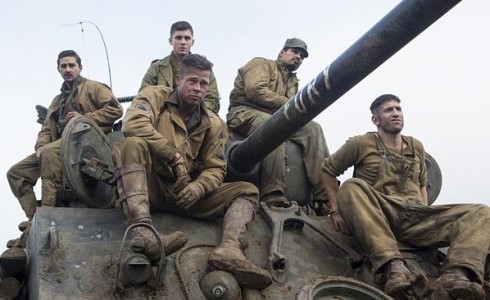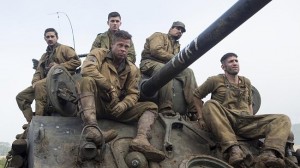Movie a Day Blog takes some weird pride in viewing FURY (2014, theatrical) as an amalgam of two films I produced, THE BEAST (1988) and A MIDNIGHT CLEAR (1992). As in THE BEAST, the primary focus of FURY is on a tank crew, how they interact and interrelate, and the toll war takes on them and their mechanical transport.
The timing of FURY, the final push into Germany in the spring of 1945 that began with the Battle of the Bulge, was the same as that of MIDNIGHT CLEAR, and several of our young male characters resembled the tank crew assembled under Brad Pitt in FURY.
That said, FURY is a more traditional update on the classic American World War II movie than an attempt to break new ground in the genre.
David Ayers, who wrote and directed his original story, made one of the better police movies of recent years, END OF WATCH (2012), and wrote the nasty part that won Denzel Washington his Best Actor Oscar, TRAINING DAY (2001). He’s not afraid to show the hyper-reality of war, particularly through the vivid depiction of tank and anti-tank battles.
And he’s assembled a good group of characters who follow the Hollywood war movie formula of the foxhole picture, in which one WASP, one ethnic person, one Southerner/redneck, and one intellectual, often the new recruit have to learn to work and survive together.
This structure goes back as far as Stephen Crane’s groundbreaking stream-of-consciousness Civil War novel, THE RED BADGE OF COURAGE, and John Huston’s failed 1951 adaptation. Ayers doesn’t improve on the formula, but he gets terrific performances from almost all of his cast, particularly Pitt, rookie grunt Logan Lerman, Mexican-American Michael Pena, who’s done two previous films for Ayers, and surprisingly, no amazingly, Shia LaBoeuf.
Whatever chaos is going on his personal life, LaBoeuf seems to have finally matured as an actor, and in NYMPHOMANIAC: VOl. I (2013, Movie a Day Blog 9/) and now in FURY, his religious-minded character is believable, moving and even admirable.
John Bernthal goes a little over the top as the redneck named Coon-Ass (some stereotypes die hard), and an overly staged scene with two attractive German girls sort of getting raped doesn’t play to Ayers’ strength. FURY’s strongest quality is its straight-forward mission (advance through Germany) and execution of that mission, which is to kill as many Germans as possible.
Pitt breaks every clause of the Geneva Convention at some point or other in FURY, but it’s all for a good cause, right? Lerman, of course, plays the character who has to display moral doubt, and everyone else in the tank sort of respects him for it and sort of despises him for it, but that’s war, or at least how it’s been showed on film for the past 100 years. Remember, the genre was already well-enough established that Charlie Chaplin could spoof it with SHOULDER ARMS as early as 1918.
Ayers couldn’t have cast a better grizzled veteran than Pitt (also a producer of the film), and his scene in which he forces Lerman into the brutal world of warfare reminded me of Montgomery Clif’s initiation in THE YOUNG LIONS (1958).
Ayers had a great practical and visual special effects team on FURY, and the crossfire is brutal. The highlight of the film comes in an incredibly tense battle between a more advanced and lethal Nazi tank and the Fury (its name is painted on its gun barrel) that is brilliantly edited by Jay Cassidy and Dody Dorn.
FURY only outstays its welcome in a few ways: it’s too long (two hours and fifteen minutes is a lengthy time to spend mostly in a tank), and there are two moments near the film’s end that make no logical or rational sense, which is exactly what FURY relied on for most of its running time. They just don’t work and they rob FURY of the credibility it worked so hard to achieve in its first two hours and ten minutes. Sometimes you win the war, but you end up losing the battle.



Comments are closed